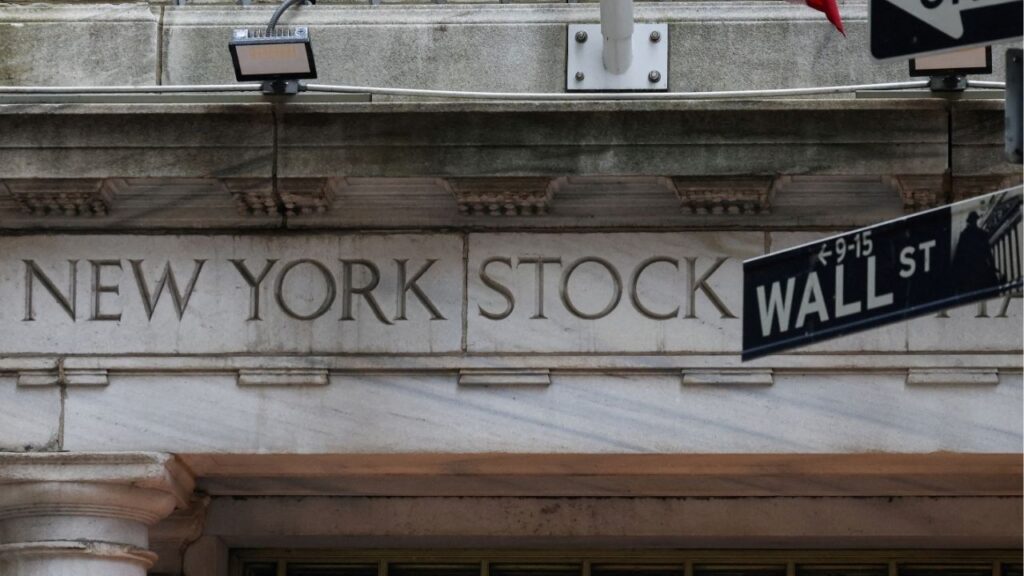Real estate experts outlined what they expect from the Fresno economy at the 19th annual Real Estate Forecast hosted by the Fresno Economic Development Corporation, Thursday, April 18, 2024. (GV Wire Composite/Paul Marshall)

- High interest rates have put a squeeze on building, buying, and investing, say brokers at the Real Estate Economic Forecast.
- Renters have more options for apartments, but making the leap to home ownership is difficult.
- Office/retail construction has slowed significantly. Industrial vacancies rise a bit in Fresno but that may not last.
Share
|
Getting your Trinity Audio player ready...
|
The Fresno Economic Development hosted a panel of experts to lay out their vision of the Fresno economy for the coming year on Thursday night.
From office space to retail stores and industrial investment and housing, real estate brokers and one builder forecast roadblocks in buying and selling with stubbornly high interest rates. Agriculture in the next year looks even worse.
Clues in real estate activity provide a sense of the economy at large, said Will Oliver, president of the Fresno EDC at the 19th Real Estate Forecast.
The event brought out not only investors, but elected officials that included Fresno Mayor Jerry Dyer and councilmembers from Fresno, Clovis and other Valley cities.
“We just need to be aware of the fact that our office sector is slowing down,” said Fresno Councilmember Annalisa Perea. “So how can we get creative with those spaces? How do we find creative ways to utilize these underutilized spaces? And we need to grow more homes here in our city. So, whether that’s market rate or affordable housing, the point that I took away is that we have a lot of work to do to bring more housing online for every sector.”
Market Has Good News for Renters
Throughout 2021 and 2022, rents increased at double-digit rates and renters had to pay them, said Robin Kane, managing director of multi-family with Northmarq. The number of available units was so limited, rents climbed at record rates.
“We were raising rents double digit for three or four years in a market where housing incomes were only going up 2-3%,” Kane said. “Eventually, you’re going to run out of renters.”
Over the last five years, 4,000 units came online in the Fresno market, bringing rental growth down to manageable levels, Kane said. Because of that, renters have many more options today than they did the same time last year.
Keeping a growing apartment supply filled, though, is a bottleneck of renters finding it difficult to make the jump to single-family homes, Kane said.
Homeowners who would otherwise be upgrading to bigger homes, opening up entry-level homes are delaying that decision, not wanting to give up their competitive interest rates, said Annie Foreman, real estate agent with Guarantee Real Estate. This has made finding homes difficult, Foreman said.
The number of active listings is effectively the same as last year. The median price is $390,000, up 6.3% from last year. Of active listings, 34.3% have reduced prices.
“We have an availability problem in California and in Fresno County, we do not have an affordability problem from my standpoint,” Foreman said. “We have had decades of not building enough.”

Focus on Build-to-Rent Homes
Coming out of the Great Recession, Wall Street investors bought 10s of thousands of homes on the cheap, with the intention of flipping them for profit, Kane said. What they found instead: Rentals can be profitable.
“They only did that because they thought they were just going to buy it and flip it,” Kane said. “What they discovered is there’s a huge segment of the rental population that does not want to rent an apartment.”
A large number of families now don’t want to own, Kane said. Having a landlord means not having to pay for everything that breaks down. The problem historically has been the stigma of being a renter in a neighborhood of homeowners, Kane said.
Major investors have been going to builders to get entire subdivisions dedicated to rentals, Kane said.
In Fresno, 38% of the single-family residents are non-owner occupied. Nationally, one in every 10 built is a rental, Kane said. Rental growth in single-family homes has exceeded apartment rents for the past three years.
While it gives options for families not ready or not wanting to buy, it also decreases supply.
“If you ask yourself where all those first-time homebuyer homes went? They’re in the hands of Wall Street and they have no intention of (selling),” Kane said.
Related Story: Controversial Industrial Project Approved With Fresno at ‘Economic ...
$78B State Deficit Could Spell Trouble for Affordable Housing
This was the first year the EDC had a speaker on affordable housing. Tyrone Roderick Williams, CEO of Fresno Housing spoke about high demand for housing.
“When I say affordable housing, it doesn’t just mean at the bottom of the economic game, but there’s a range,” Williams said. “We’re serving people who go to work everyday, but between inflation and rent increases, are finding it really challenging to one, afford rent, or if they’re looking for an apartment, that they can afford to find them.”
The Housing Authority’s newest apartment complex, The Monarch in Chinatown, opened to 3,000 applications with only 57 units, Williams said. Adding to the challenges is what could be a $78 billion deficit for the upcoming California state budget.
Affordable housing relies on state grants to make projects pencil out financially. Williams said state funding is absolutely essential to building affordable housing, but realizes cuts will have to be made.
“We understand there may be some reductions, but we’re hoping that, you know, we’re hoping that they use the reductions as a scalpel and not as an ax,” Williams said.
Water, Commodity Prices, Production Costs, Interest Rates: Is Anything Good for Farmers?
A confluence of high production costs and low returns have farmers facing a dire situation. What could be a 3 billion-pound crop means a poor outlook on the future of the nut’s price, said Sullivan Grosz, president of the ag division at Pearson Realty.
“If you’re an almond grower, almonds are going about the third year of low almond prices and it’s made it really difficult because the cost to farm almonds in particular, and really all the crops, the cost for nitrogen and fertilizers and pesticides, herbicides and labor is huge,” Grosz said.
Central Valley wine grapes typically go toward lower-tier wines and drinkers don’t have as much of an appetite for those grapes, Grosz said. He’s heard estimates that 50,000 acres of wine grapes need to be removed.
Related Story: One of CA’s ‘Largest Almond Growers’ Files for Bankruptcy. It ...
Another record crop for pistachios in 2023 looked like low pricing for the nut, but a quick sell-off in October stabilized prices, Grosz said. As California’s water laws continue to roll out, farmers are seeing land is drier than first thought. That’s affecting land prices.
Some areas farmers thought are low risk are actually medium risk, Grosz said. Some medium-risk areas might actually be high risk. High interest rates have made stable investments such as treasury bonds more attractive for institutional investors which once gobbled up farm land.
But not all is doom and gloom, said Grosz. Fresh fruit, including stone fruit and table grapes are pulling a profit. Available farm land is still selling. Of the 13,000 acres once owned by now-bankrupt fresh fruit giant Prima Wawona, only about 940 acres remain unsold.
“Unknowns scare people, so it’s important that they figure out if there are going to be restrictions, what are they going to be? Because if they don’t know, it’s hard for them to want to purchase in those areas because it’s more risk,” Grosz said.

Industrial Vacancies Rising, Market Still Absorbing Space
The warehouse and manufacturing jobs, as well as everything it takes to supply the industrial sector make up 21% of the workforce in Fresno County, said Nick Audino, senior vice president with Newmark Pearson Commercial. The industrial sector also makes up a quarter of sales tax revenue.
But in Fresno, industrial expansion has largely gone to other areas because of a lack of available space and cost to build, Audino said.
Construction costs have increased 50%.
Related Story: Mega-Warehouse Builder Embraces Visalia, Says Fresno ‘Not as ...
Of late, some vacancies have opened up. Brokers have become accustomed to turning away major logistics companies and manufacturers looking to locate to Fresno County.
But vacancy rates have risen somewhat from near-zero to 2.9%, Audino said. High interest rates have made the capital-intensive sector less attractive, so Audino does picture those rates to increase, but not above national averages.
The market is still absorbing what comes available. Despite a slowdown, buyers and tenants still outnumber available space, Audino said.
“There are fewer buyers and tenants looking around than there were in early 2023, but you know, we’ve got an election year and some uncertainty in the market, which always causes pause,” Audino said.
Interest Rates Keeping Office and Retail Tempered
Considering the high cost to rent space, most retail tenants don’t want to waste time leasing in poor locations, said Rachel Orlando, vice president of Retail California. That’s made demand for high-visibility spaces competitive, she said.
“Rents are going up, if they’re paying high rents, they want the best center,” Orlando said.
The high cost to build and high interest rates have slowed construction down.
The same goes for office, said Tony Cortopassi, managing director for Cushman & Wakefield. In some areas nationally, office vacancies have reached 21%. In Fresno, where developers didn’t overbuild at the height of the market, vacancy has sat around 7%.
Property owners are signing office tenants on for longer leases to make up for uncertainty in the market.
Medical has largely driven demand for office space, Cortopassi said.
Coming Opportunities at Good Prices for Investors
Brett Visintainer, principal for the Visintainer Group said there is a lot of money on the sidelines looking for opportunities. With high interest rates, investors are looking to dump cash into properties rather than finance them.
This year, Visintainer said 20% of commercial loans are going to mature. That could mean for investors having to cover a lot of loans. And at interest rates topping 7%, finding a property with a return higher than the cost to borrow is difficult. Banks also want more money from investors before granting loans or refinances.
“People don’t have the money. If you own ten different properties and your loans are all maturing and you have to come in and put up the money to make the difference and you can’t cover it all, you’re going to have to start picking out which ones you don’t want or give back to the bank,” Visintainer said.
RELATED TOPICS:
Categories

Venezuela Blames Explosions on US “Military Aggression”

Venezuela Says It Rejects “Military Aggression” by the US

Wall Street Ends Mixed at the Top of the New Year

Tejon Pass Rest Areas on I-5 Closed Due to Rainfall















